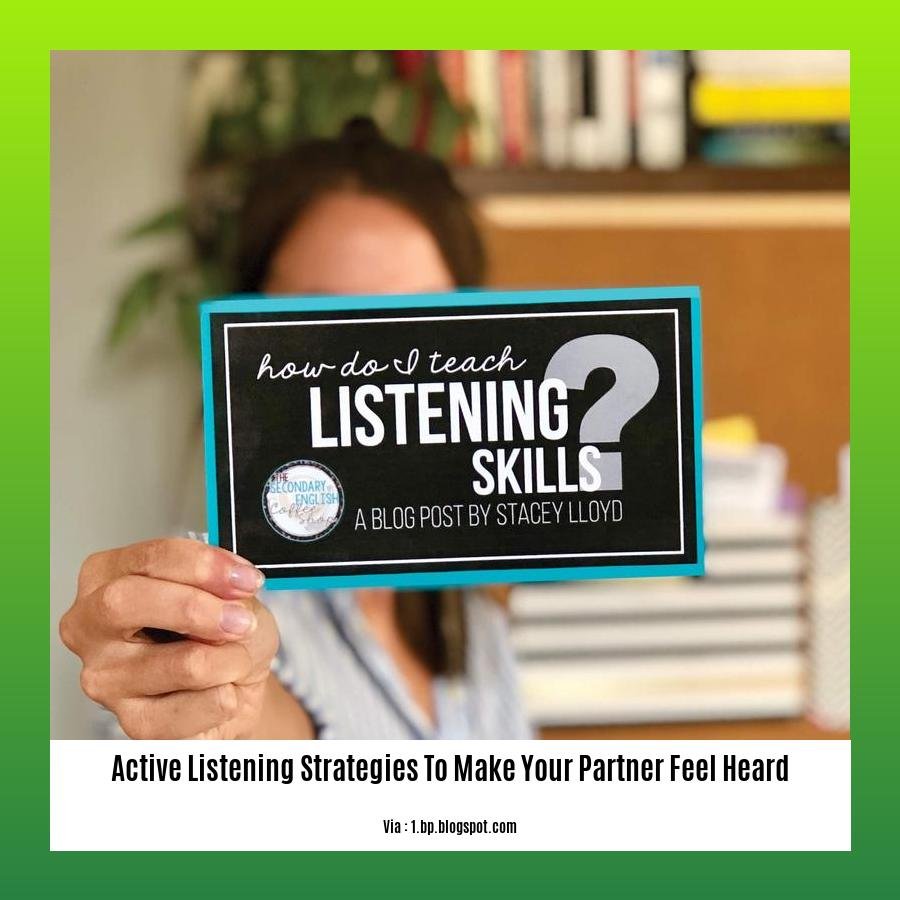Looking for ways to make your partner feel heard? Active listening is a powerful skill that can deepen your connection and strengthen your relationship. It involves paying full attention to what your partner is saying, both verbally and nonverbally, and responding in a way that shows you understand their perspective. By practicing active listening, you can create a safe and supportive space where your partner feels valued and respected, and your bond can grow stronger. In this article, we’ll explore the Active Listening Strategies to Make Your Partner Feel Heard.
Key Takeaways:

- Be present and attentive.
- Avoid interrupting.
- Paraphrase and summarize the message.
- Ask open-ended questions.
- Show empathy.
- Adapt your listening style based on the speaker and situation.
Active Listening Strategies to Make Your Partner Feel Heard
When you actively listen to your partner, you create a safe and supportive space where both of your voices are truly heard. This strengthens your connection, fosters empathy, and makes your conversations more meaningful. Here are some tips for becoming a better active listener:
- Make eye contact and give your full attention. When you’re listening to your partner, make eye contact and turn your body towards them. This shows that you’re interested in what they have to say and that you value their perspective.
- Give verbal cues. Nodding your head, saying “uh-huh,” or “I see,” shows that you’re following the conversation and that you’re engaged in what your partner is saying.
- Ask questions. Ask open-ended questions to encourage your partner to elaborate on what they’re saying. This shows that you’re interested in their thoughts and feelings, and it helps you to better understand their point of view.
- Paraphrase and reflect. Sometimes it can be helpful to paraphrase what your partner has said to make sure that you understand them correctly. You can also reflect on their feelings by saying things like, “It sounds like you’re feeling frustrated” or “I can tell that you’re really excited about this.”
- Be empathetic. Try to put yourself in your partner’s shoes and understand their perspective. This doesn’t mean you have to agree with them, but it will help you to be more understanding and compassionate.
By following these tips, you can become a more active listener and improve your communication skills. This will lead to stronger relationships and more fulfilling conversations with your partner.
Here is a step-by-step guide on how to actively listen your partner:
- Give your full attention. Put away your phone, make eye contact, and turn your body towards your partner.
- Listen without interrupting. Let your partner finish their thought before you say anything.
- Ask clarifying questions. If you don’t understand something, ask your partner to clarify.
- Reflect on what your partner has said. Summarize what you’ve heard and ask your partner if you’ve understood them correctly.
- Validate your partner’s feelings. Let your partner know that you understand how they’re feeling, even if you don’t agree with them.
- Respond with empathy and support.
Explore active listening skills for better relationship communication to master the art of attentive listening. Discover how to be an engaged listener to improve your romantic partnership and delve into techniques for empathetic listening to enhance intimacy.
Asking clarifying questions to delve deeper
Key Takeaways:
- Unveil the finer details: Clarifying questions encourage the speaker to provide more intricate information, giving you a deeper understanding of their perspective.
- Foster engagement and connection: Active listening, including clarifying questions, demonstrates genuine interest and enhances the emotional connection between you and the speaker.
- Curb hasty judgments: Asking for clarification can delay premature reactions, allowing you to fully comprehend the speaker’s viewpoint before forming opinions.
- Strengthen mutual understanding: Active listening with clarifying questions ensures that both parties are on the same page, fostering empathy and reducing misunderstandings.
-
Elevate communication skills: Practicing clarifying questions sharpens your communication abilities, empowering you to engage in meaningful and effective conversations.
-
Types of Clarifying Questions
- “Can you elaborate on that further?“
- “What do you mean by…?”
-
“Could you give me an example?“
-
When to Ask Clarifying Questions
- When you’re unsure about a statement.
- When you want to get more details.
- When you want to check your understanding.
-
When you want to encourage the speaker to continue talking.
-
How to Ask Clarifying Questions
- Use a respectful and non-judgmental tone.
- Avoid interrupting the speaker.
- Be patient and give the speaker time to respond.
- Ask one question at a time.
Example
Imagine your partner telling you about a difficult conversation they had at work. Instead of simply responding with “I understand,” you could ask clarifying questions such as:
- “Can you tell me more about what your colleague said?“
- “What was your reaction to their comments?“
These questions show that you’re engaged in the conversation and that you want to understand your partner’s perspective.
Conclusion
Asking clarifying questions is an essential part of active listening. By using these questions, you can delve deeper into conversations, foster stronger connections, and improve your overall communication skills.
Citation:
- Psychology Today: The Importance of Clarifying Questions
Avoiding Interruptions to Show Respect
It’s easy to get caught up in our own thoughts and opinions, forgetting the importance of letting our partners fully express themselves. Interrupting shows disrespect, hinders communication, and erodes trust. Here’s how to avoid interrupting and show your partner you value their voice:
-
Take a deep breath: When you feel the urge to interrupt, take a deep breath and remind yourself to listen.
-
Practice patience: Allow your partner to finish their thoughts without interjecting. It shows you’re interested in what they have to say.
-
Use nonverbal cues: Nod, smile, and maintain eye contact to indicate you’re engaged in the conversation.
-
Ask clarifying questions: If you don’t understand something, ask a clarifying question instead of interrupting. This shows you’re paying attention.
-
Be mindful of body language: Avoid crossed arms or legs, which can convey disinterest or even hostility.
Key Takeaways:
- Interrupting shows disrespect and hinders communication.
- Practice patience and let your partner finish their thoughts.
- Use nonverbal cues like nodding and eye contact to show engagement.
- Ask clarifying questions instead of interrupting to show you’re listening.
- Be mindful of your body language to convey interest and respect.
Relevant URL Source:
- 5 Rules for Active Listening That Will Save Your Relationship
Summarizing Key Points to Ensure Clarity
When practicing active listening, summarizing key points to ensure clarity is crucial for fostering meaningful conversations. Here are a few practical tips:
- Ask clarifying questions. Seek further explanation or examples to grasp the speaker’s message fully.
- Repeat or rephrase. Restate what you’ve heard in your own words to demonstrate understanding.
- Reflect on feelings. Acknowledge the emotional undertones conveyed, showing empathy and understanding.
Key Takeaways:
- Clarifying questions deepen understanding and minimize misunderstandings.
- Summarizing shows that you’re actively engaged and attentive.
- Reflecting on feelings builds emotional connection and trust.
Source:
- Active Listening: How to Truly Listen and Be Heard, Psychology Today:

FAQ
Q1: How can I show empathy while actively listening?
A1: Empathy involves understanding and reflecting the speaker’s emotions. Use phrases like “I understand why you feel that way” or “It seems like you’re feeling a bit frustrated.”
Q2: What if I find myself interrupting my partner?
A2: Practice self-awareness and train yourself to wait until they finish speaking. Remember that active listening is about giving undivided attention to your partner’s message.
Q3: Is it important to maintain eye contact throughout the conversation?
A3: Maintaining eye contact shows engagement and attention. However, avoid being overly intense or staring, as this can make your partner uncomfortable.
Q4: What are some non-verbal cues I can use to indicate active listening?
A4: Non-verbal cues such as nodding, leaning forward, and having an open posture signal that you are engaged and interested in what your partner has to say.
Q5: How can I avoid making assumptions or judgments while listening?
A5: Approach conversations with an open mind and avoid jumping to conclusions. Focus on understanding your partner’s perspective without evaluating or critiquing their views.










